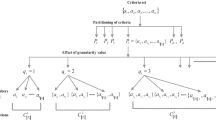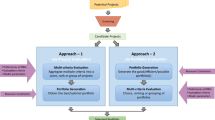Abstract
In recent years, cloud computing is becoming an attractive research topic for its emerging issues and challenges. Not only in research but also the enterprises are rapidly adopting cloud computing because of its numerous profitable services. Cloud computing provides a variety of quality of services (QoSs) and allows its users to access these services in the form of infrastructure, platform and software on a subscription basis. However, due to its flexible nature and huge benefits, the demand for cloud computing is rising day by day. As a circumstance, many cloud service providers (CSPs) have been providing services in the cloud market. Therefore, it becomes significantly cumbersome for cloud users to select an appropriate CSP, especially considering various QoS criteria. This paper presents a hybrid multi-criteria decision-making (H-MCDM) algorithm to find a solution by considering different conflicting QoS criteria. The proposed algorithm takes advantage of two well-known MCDM algorithms, namely analytic network process (ANP) and VIseKriterijumska Optimizacija I Kompromisno Resenje (VIKOR), to select the best CSP or alternative. Here, ANP is used to categorize the criteria into subnets and finds the local rank of the CSPs in each subnet, followed by VIKOR, to find the global rank of the CSPs. H-MCDM considers both beneficial and non-beneficial criteria and finds the CSP that holds the maximum and minimum values of these criteria, respectively. We demonstrate the performance of H-MCDM using a real-life test case (case study) and compare the results to show the efficacy. Finally, we perform a sensitivity analysis to show the robustness and stability of our algorithm.



Similar content being viewed by others
References
Kumar GS, Steve V, Rajkumar B (2013) A framework for ranking of cloud computing services. Fut Gener Comput Syst 29(4):1012–1023
Varghese B, Buyya R (2018) Next generation cloud computing: new trends and research directions. Fut Gen Comput Syst 79:849–861
Gary G, Wakefield Robin L, Sanghyun K (2015) The effects of it capabilities and delivery model on cloud computing success and firm performance for cloud supported processes and operations. Int J Inf Manag 35(4):377–393
Rajkumar B, Shin YC, Srikumar V, James B, Ivona B (2009) Cloud computing and emerging it platforms: vision, hype, and reality for delivering computing as the 5th utility. Fut Gen Comput Syst 25(6):599–616
Hwang K, Dongarra J, Fox Geoffrey C (2013) Distributed and cloud computing: from parallel processing to the internet of things. Morgan Kaufmann
Pande SK, Panda SK, Das S, Alazab M, Sahoo KS, Luhach AK, Nayyar A (2020) A smart cloud service management algorithm for vehicular clouds. IEEE Trans Intell Transp Syst. https://doi.org/10.1109/TITS.2020.3021075
Rania E-G, Eli H, Olsen Dag H (2016) Understanding cloud computing adoption issues: a Delphi study approach. J Syst Softw 118:64–84
Panda Sanjaya K, Jana Prasanta K (2019) An energy-efficient task scheduling algorithm for heterogeneous cloud computing systems. Clust Comput 22(2):509–527
Caesar W, Buyya R, Ramamohanarao K (2020) Modeling cloud business customers utility functions. Fut Gen Comput Syst 105:737–753
Panda Sanjaya K, Jana Prasanta K (2016) Uncertainty-based qos min–min algorithm for heterogeneous multi-cloud environment. Arab J Sci Eng 41(8):3003–3025
Panda Sanjaya K, Jana Prasanta K (2017) Sla-based task scheduling algorithms for heterogeneous multi-cloud environment. J Supercomput 73(6):2730–2762
Le S, Hai D, Khadeer HF, Khadeer HO, Elizabeth C (2014) Cloud service selection: state-of-the-art and future research directions. J Netw Comput Appl 45:134–150
Chandrashekar J, Gangadharan GR, Ugo F, Rajkumar B (2019) Selcloud: a hybrid multi-criteria decision-making model for selection of cloud services. Soft Comput 23(13):4701–4715
Kheybari S, Rezaie FM, Farazmand H (2020) Analytic network process: an overview of applications. Appl Math Comput 367:124780
Gao Z, Liang RY, Xuan T (2019) Vikor method for ranking concrete bridge repair projects with target-based criteria. Results Eng 3:100018
Jahan A, Edwards KL (2013) Vikor method for material selection problems with interval numbers and target-based criteria. Mater Des 47:759–765
Jian-qiang Wang L, Peng HZ, Chen X (2014) Method of multi-criteria group decision-making based on cloud aggregation operators with linguistic information. Inf Sci 274:177–191
Tapoglou N, Mehnen J (2016) Cloud-based job dispatching using multi-criteria decision making. Procedia CIRP 41:661–666
Sengupta RN, Gupta A, Dutta J (2016) Decision sciences: theory and practice. CRC Press
Wang M, Liu Y (2013) Qos evaluation of cloud service architecture based on anp. In: Proceedings of the international symposium on the analytic hierarchy process
Ranjan KR, Chiranjeev K (2018) A multi criteria decision making method for cloud service selection and ranking. IJACI 9(3):1–14
Sen L, Chan Felix TS, Wenxue R (2016) Decision making for the selection of cloud vendor: an improved approach under group decision-making with integrated weights and objective/subjective attributes. Expert Syst Appl 55:37–47
Super Decision (2020) Super decision cdf. http://www.superdecisions.com/downloads/. Accessed on 1 Sept 2020
Author information
Authors and Affiliations
Corresponding author
Rights and permissions
About this article
Cite this article
Saha, M., Panda, S.K. & Panigrahi, S. A hybrid multi-criteria decision making algorithm for cloud service selection. Int. j. inf. tecnol. 13, 1417–1422 (2021). https://doi.org/10.1007/s41870-021-00716-9
Received:
Accepted:
Published:
Issue Date:
DOI: https://doi.org/10.1007/s41870-021-00716-9




